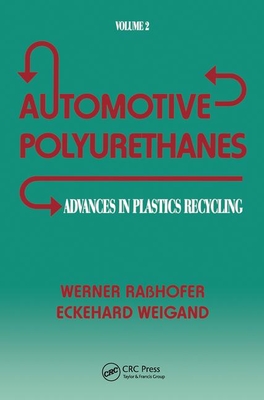This book details the materials and methods, and the problems involved in recycling plastics in the automotive industry. Going beyond recovery, the authors examine the processes and applications involved in putting recovered material to economic use in marketable products. The text is supplemented with more than 60 tables providing useful data on polyurethane recycling processes and chemistry. More than 60 photographs, micrographs, diagrams and flowcharts illustrate materials, processes and products. This information will be useful to personnel involved in the research, development, and recycling of plastics and other polymeric materials for automotive applications.
The technology for the recovery, reprocessing and reuse of automotive polyurethanes in Europe is highly developed and serves as a successful example for other areas. This new book by a leading authority on this technology details the materials and methods, as well as the problems, involved in this work. Going beyond recovery, the authors examine the processes and applications involved in putting recovered material to economic use in marketable products. The text is supplemented with more than 60 tables providing useful data on polyurethane recycling processes and chemistry. More than 60 photographs, micrographs, diagrams and flowcharts illustrate materials, processes and products.
In addition to a detailed presentation of this technology, the book provides a review of European regulation and programs dealing with automotive plastics recycling, as well as the voluntary activities of industry organizations and individual companies.
The information in this new book will be useful to personnel involved in the research, development and recycling of plastics and other polymeric materials for automotive applications. The details of reprocessing chemistry will be especially useful to polymer chemists working with polyurethanes.
Tables
Much of the technical data in this book is presented in 64 tables. Here is a small sample of this material: o Plastic Components in Used Cars
o Reaction conditions for glycolysis of the Bayflex 110-80 System o Parameters of the Continuous Pebra-Magna Glycolysis Process o Physical Properties of RIM Polyurethanes Obtained by Using Glycolysis Polyols (20% Filler) o Comparison of the Mechanical Properties Baydur® STR from Virgin Polyol and from 70% RRIM Recycled Polyol o Flame Retardant Behavior of Adhesive-Pressed Boards Based on EA Foam
Illustrations
More than 60 photographs, micrographs, flowcharts and diagrams illustrated processes and materials, including finished products made of recycled polyurethanes. Here is a small sampling of these figures. o Glycolysis cause/effect diagram o Direct RRIM-PU recycling via glycolysis o Automotive RIM parts for glycolysis o Flowchart of a discontinuous glycolysis process o Side panels produced by the RRIM process using Bayflex® recycled polyol o Reprocessing and processing of contaminated polyurethanes o Flowchart of the three-stream RIM process o Flowchart for the production of adhesive-pressed articles o "Grass stone" made from granulated RIM with adhesive pressing
Get Advances in Plastics by at the best price and quality guranteed only at Werezi Africa largest book ecommerce store. The book was published by Taylor & Francis Inc and it has pages. Enjoy Shopping Best Offers & Deals on books Online from Werezi - Receive at your doorstep - Fast Delivery - Secure mode of Payment
 Jacket, Women
Jacket, Women
 Woolend Jacket
Woolend Jacket
 Western denim
Western denim
 Mini Dresss
Mini Dresss
 Jacket, Women
Jacket, Women
 Woolend Jacket
Woolend Jacket
 Western denim
Western denim
 Mini Dresss
Mini Dresss
 Jacket, Women
Jacket, Women
 Woolend Jacket
Woolend Jacket
 Western denim
Western denim
 Mini Dresss
Mini Dresss
 Jacket, Women
Jacket, Women
 Woolend Jacket
Woolend Jacket
 Western denim
Western denim
 Mini Dresss
Mini Dresss
 Jacket, Women
Jacket, Women
 Woolend Jacket
Woolend Jacket
 Western denim
Western denim
 Mini Dresss
Mini Dresss





































